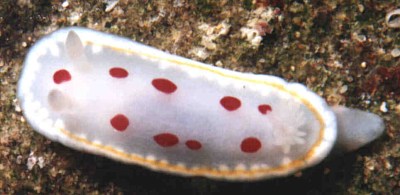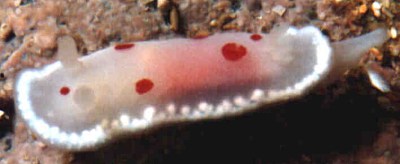

Chromodoris heatherae
Gosliner, 1994
Order: NUDIBRANCHIA
Suborder: DORIDINA
Superfamily: EUDORIDOIDEA
Family: Chromodorididae
DISTRIBUTION
South Africa - temperate waters from Atlantic coast of the Cape Peninsula to Transkei.
PHOTO
Brazen Head, Transkei, SOUTH AFRICA - 28m, June 2000. Upper: 14mm long. Lower: 10mm. Photos: Valda Fraser.
Translucent white mantle and body, with white rhinophores and gills. Irregular opaque white band around mantle edge formed from ramifying epithelial mantle glands. In some specimens there is a thin submarginal yellow line around the mantle on the inside edge of the mantle glands. It apparently does not continue around in front of the rhinophores. Most specimens have a sereis of large red spots on the mantle, but in a few cases these are absent.
References:
• Gosliner, T.M. (1981) Nudibranchs of Southern Africa. Chromodoris sp 1., p.76.
• Gosliner, T.M. (1994) New species of Chromodoris and Noumea (Nudibranchia: Chromodorididae) from the western Indian Ocean and southern Africa. Proceedings of the Californian Academy of Sciences, 48(12): 239-252.
Rudman, W.B., 2000 (July 9) Chromodoris heatherae Gosliner, 1994. [In] Sea Slug Forum. Australian Museum, Sydney. Available from http://www.seaslugforum.net/find/chroheat
Related messages
Chromodoris heatherae feeding
February 25, 2004
From: Charles Rowe


Hi Bill,
Fairly recently you asked me to send any further shots I took of Chromodoris heatherae as you were interested in their feeding habits. I attach one taken on 14 February 2004 at Whitesands, Port Elizabeth [South Africa] in which it appears to be eating whatever it is on. Maybe I am mistaken but I am sure you will be able to sort it out.
It was taken on Saturday when the conditions were cold, 14 degrees C and only 3 metres vis. 14 degrees for our Summer is miserable especially as it was 26 on the surface! Thanks for your comments [#12225] about Hypselodoris regina which I think is a beautiful beast!
See ya.
Charles...
Charles.Rowe@delta.co.za
Rowe, C., 2004 (Feb 25) Chromodoris heatherae feeding. [Message in] Sea Slug Forum. Australian Museum, Sydney. Available from http://www.seaslugforum.net/find/12305Thanks Charles,
It certainly seems to be interested in this orange sponge but a bit hard to be sure. The little purple and orange amphipods are quite spectacular. I'm interested in the habits of all opisthobranchs, but the reason I was particularly interested in the feeding habits of this species was that C. heatherae appears to have a rather distinct colour form which lacks a yellow border. Without comparing the anatomy of animals with and without this border I thought it might be useful to see if there were consistent behavioural differences between yellow-bordered and borderless animals. Perhaps the different colour forms ate different sponges? If so, this might suggest we had two different but very similarly coloured species like the many red-spotted species in southeastern Australia
Best wishes
Bill Rudman
Re: Chromodoris heatherae from Port Elizabeth
September 29, 2003
From: Charles Rowe
Dear Bill,
The "beast" was approximately 10 to 20mm in length but it was not easy to estimate. Definitely small! Looking at the photos you have included for me to compare the beast with I would say it might be the same but only if they are very variable.
Charles Rowe
bumff@mweb.co.za
Thanks Charles,
We still have a lot to learn about these animals worldwide so to some extent the Forum is a 'selfhelp' institution. Amateur naturalists have always been an invaluable help to professional scientists, who are very few in number. I agree that your animal appears to differ from 'typical' C. heatherae in some aspects of the colour pattern, but as we know little about that species, it's a bit hard to be sure how much colour variation it has. Perhaps you would be willing to help by keeping an eye out for red-spotted chromodorids. If your were able to photograph where they live - preferably what sponges they are frequenting - and catch them laying eggs, it would help us determine how many red-spotted species occur in your part of the world. Most species are very particular as to which species of sponge they will eat, and often the egg ribbons of diiferent species will be quite different, so even before looking at their anatomy we can often get some good clues to what is and what isn't a different species.
Best wishes,
Bill Rudman
Chromodoris heatherae from Port Elizabeth
September 25, 2003
From: Charles Rowe

This morning [21 September 2003] my partner and myself dived Evans Peak which is 23 kilometers off Port Elizabeth, South Africa and spotted the nudibranch below. Can anyone help me to identify it? It was in approximately 26 metres of water.
Charles Rowe
bumff@mweb.co.za
Rowe, C., 2003 (Sep 25) Chromodoris heatherae from Port Elizabeth. [Message in] Sea Slug Forum. Australian Museum, Sydney. Available from http://www.seaslugforum.net/find/11001
Dear Charles,
I am pretty sure this is Chromodoris heatherae, but in that species, as you will see for the photos already on the Forum, there is usually a submarginal yellow line around the mantle. There appears to be a hint of that yellow line in the close-up alongside but I can't be sure. Perhaps you could check your photos to see if you can see one.
Why I am not sure is that in southeastern Australia there is a group of very similarly coloured red-spotted species [see Red-spotted Chromodorids Page] and so its possible subtle difference in colour pattern may mean there are more than one red-spotted species in South Africa as well.
Also of interest is the pink sponge your animal is on. If I found that in southeastern Australia I would think it was the common pink Darwinella species, which many of the red-spotted species feed on. Your photo is an interesting addition. It would be useful to have some indication of size if you can.
Best wishes,
Bill Rudman
Chromodoris heatherae from South Africa
July 11, 2000
From: Valda Fraser


Dear Bill
I found this nudibranch in Gosliner, 1987 (page 76 no 112). Has it been described yet? Do you think both these photos are of the same animal?
Upper photo: 14mm long
Lower photo: 10mm long
Locality: Brazen Head, Transkei, SOUTH AFRICA - 28m
Date: June 2000
Regards
Valda
iti04937@mweb.co.za
Fraser, V., 2000 (Jul 11) Chromodoris heatherae from South Africa. [Message in] Sea Slug Forum. Australian Museum, Sydney. Available from http://www.seaslugforum.net/find/2662Dear Valda,
Yes this species is now called Chromodoris heatherae Gosliner, 1994.
In the original description Gosliner says that only some specimens have the submarginal yellow line and some lack both the yellow line and red spots.
Best wishes,
Bill Rudman.
